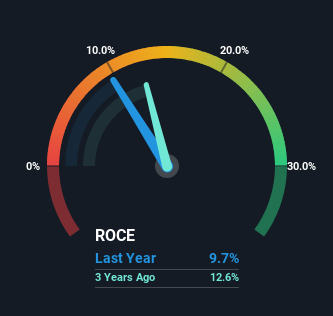- Malaysia
- /
- Wireless Telecom
- /
- KLSE:MAXIS
Maxis Berhad (KLSE:MAXIS) Could Be At Risk Of Shrinking As A Company

When researching a stock for investment, what can tell us that the company is in decline? When we see a declining return on capital employed (ROCE) in conjunction with a declining base of capital employed, that's often how a mature business shows signs of aging. Trends like this ultimately mean the business is reducing its investments and also earning less on what it has invested. So after glancing at the trends within Maxis Berhad (KLSE:MAXIS), we weren't too hopeful.
What Is Return On Capital Employed (ROCE)?
For those who don't know, ROCE is a measure of a company's yearly pre-tax profit (its return), relative to the capital employed in the business. The formula for this calculation on Maxis Berhad is:
Return on Capital Employed = Earnings Before Interest and Tax (EBIT) ÷ (Total Assets - Current Liabilities)
0.097 = RM1.7b ÷ (RM23b - RM5.8b) (Based on the trailing twelve months to March 2024).
Therefore, Maxis Berhad has an ROCE of 9.7%. Even though it's in line with the industry average of 10%, it's still a low return by itself.
See our latest analysis for Maxis Berhad

In the above chart we have measured Maxis Berhad's prior ROCE against its prior performance, but the future is arguably more important. If you're interested, you can view the analysts predictions in our free analyst report for Maxis Berhad .
So How Is Maxis Berhad's ROCE Trending?
We are a bit worried about the trend of returns on capital at Maxis Berhad. Unfortunately the returns on capital have diminished from the 15% that they were earning five years ago. Meanwhile, capital employed in the business has stayed roughly the flat over the period. This combination can be indicative of a mature business that still has areas to deploy capital, but the returns received aren't as high due potentially to new competition or smaller margins. If these trends continue, we wouldn't expect Maxis Berhad to turn into a multi-bagger.
The Bottom Line
In summary, it's unfortunate that Maxis Berhad is generating lower returns from the same amount of capital. It should come as no surprise then that the stock has fallen 19% over the last five years, so it looks like investors are recognizing these changes. With underlying trends that aren't great in these areas, we'd consider looking elsewhere.
Like most companies, Maxis Berhad does come with some risks, and we've found 2 warning signs that you should be aware of.
While Maxis Berhad may not currently earn the highest returns, we've compiled a list of companies that currently earn more than 25% return on equity. Check out this free list here.
New: Manage All Your Stock Portfolios in One Place
We've created the ultimate portfolio companion for stock investors, and it's free.
• Connect an unlimited number of Portfolios and see your total in one currency
• Be alerted to new Warning Signs or Risks via email or mobile
• Track the Fair Value of your stocks
Have feedback on this article? Concerned about the content? Get in touch with us directly. Alternatively, email editorial-team (at) simplywallst.com.
This article by Simply Wall St is general in nature. We provide commentary based on historical data and analyst forecasts only using an unbiased methodology and our articles are not intended to be financial advice. It does not constitute a recommendation to buy or sell any stock, and does not take account of your objectives, or your financial situation. We aim to bring you long-term focused analysis driven by fundamental data. Note that our analysis may not factor in the latest price-sensitive company announcements or qualitative material. Simply Wall St has no position in any stocks mentioned.
Have feedback on this article? Concerned about the content? Get in touch with us directly. Alternatively, email editorial-team@simplywallst.com
About KLSE:MAXIS
Maxis Berhad
An investment holding company, provides a suite of converged telecommunications, digital, and related services and solutions in Malaysia and internationally.
Proven track record and fair value.
Similar Companies
Market Insights
Community Narratives



